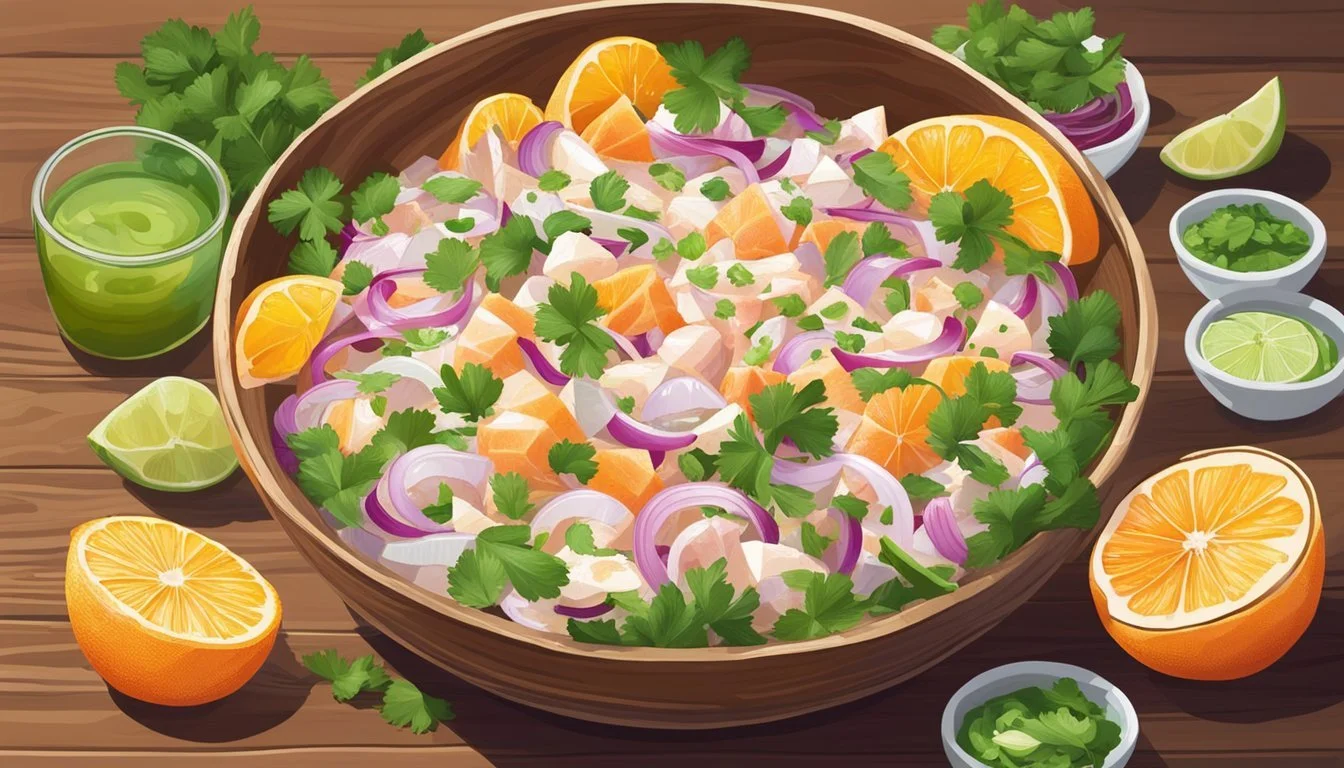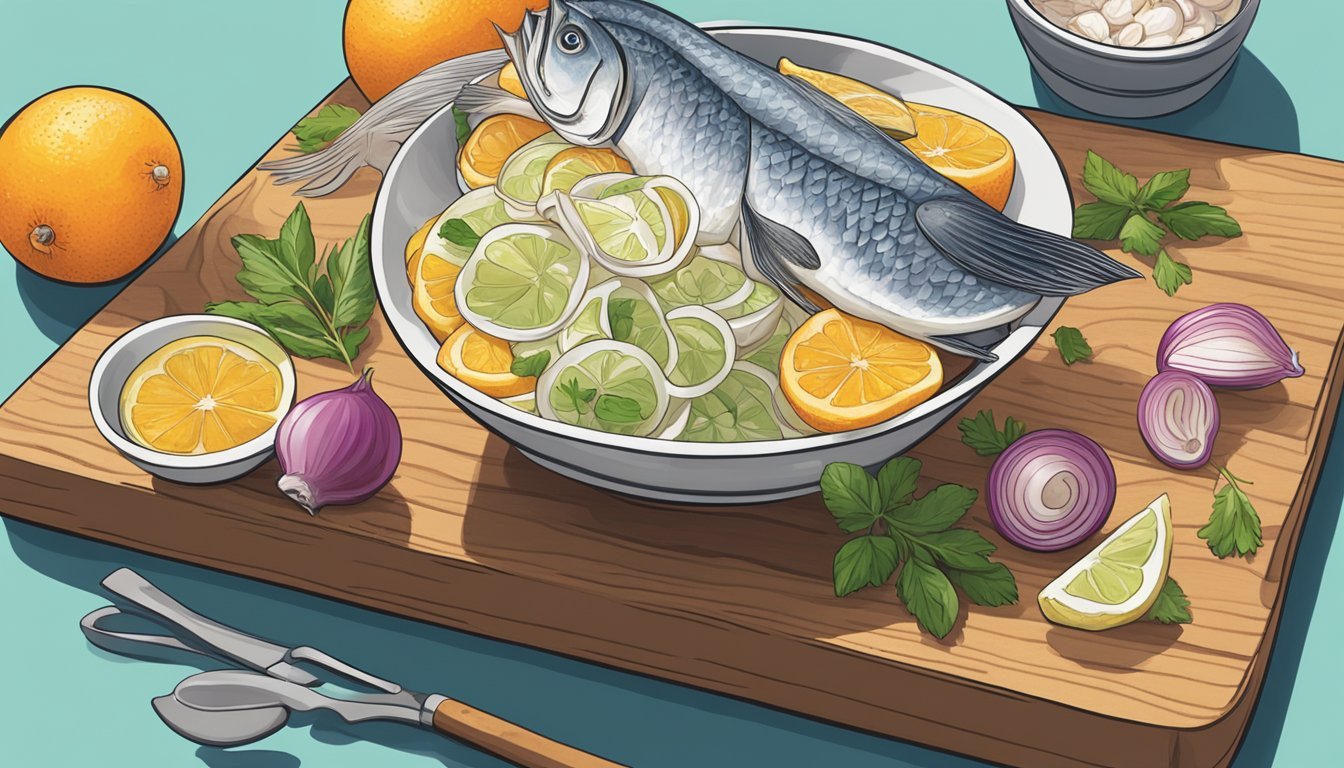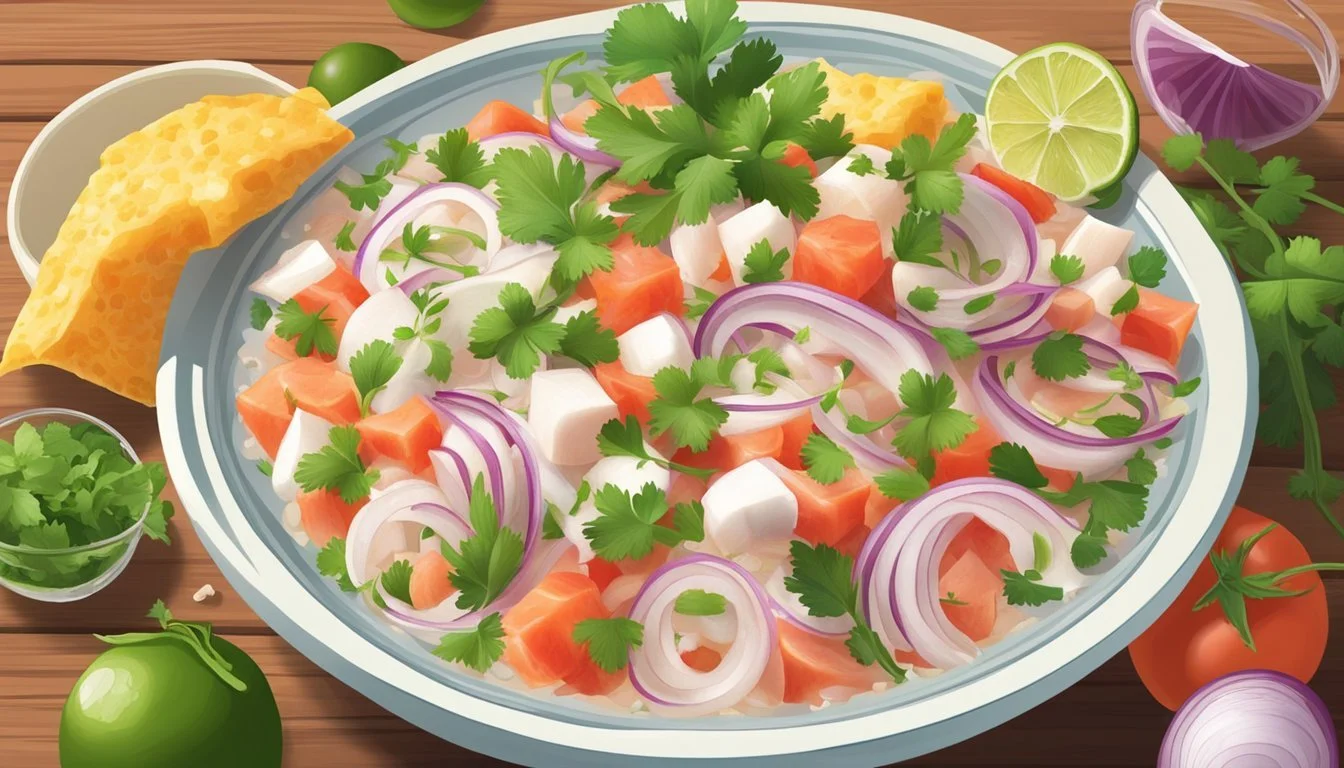How Long Does Freshly Prepared Ceviche Last?
Shelf Life and Storage Insights
Ceviche, a beloved seafood dish originating from the coastal regions of Latin America, is known for its vibrant flavors and fresh ingredients. Traditionally prepared by marinating raw fish (What wine goes well with fish?) in citrus juices, which effectively "cook" the proteins through acid denaturation, ceviche is a refreshing meal that has gained popularity worldwide. The dish's freshness, a key component of its appeal, is largely dependent on how long it retains its quality after preparation.
The shelf life of ceviche is a crucial consideration, as the delicate nature of raw fish demands careful handling. Typically, ceviche should be consumed within 24 hours of preparation to ensure the best taste and texture, although it can remain safe to eat for up to two days when refrigerated. After this period, even though the acidity of the citrus juices can prolong the dish's edibility, the fish's texture continues to degrade, leading to a less desirable culinary experience.
Storing ceviche in the refrigerator is essential in slowing down the spoiling process and preventing bacterial growth. However, the culinary experts advise against relying on refrigeration to extend the life of ceviche significantly. It is advisable to consume ceviche shortly after it's made to enjoy its fresh, bright flavors and firm, appealing texture that characterize the dish at its peak freshness.
Understanding Ceviche
This section explores the essence of ceviche, tracing its roots and detailing its primary components that make it a distinctive Latin American dish.
Defining Ceviche
Ceviche is a culinary delight typically made from raw fish cured in acidic juices, predominantly lemon or lime. It is a fresh, cold dish that relies on the acid within citrus juices to "cook" the fish, affecting its texture and flavor without the use of heat.
History and Origin
Ceviche has its origins in Latin America, with Peru often cited as the dish's birthplace. This seafood (What wine goes well with seafood?) staple embodies a fusion of indigenous and Spanish cultural influences. Variations of ceviche are found throughout Latin America, including notable versions from Peru and Chile that highlight regional tastes and variations.
Key Ingredients
The quintessential ingredients of ceviche are as follows:
Raw Fish: The cornerstone of the dish, often seabass or tilapia.
Citrus Juices: Lemon and lime are crucial for their acid content, which cures the fish.
Onions: Red or sweet onions provide a sharp, crisp note.
Cilantro: (how long does cilantro last?) Fresh cilantro adds a vibrant, herbaceous flavor.
Chili: Adjusts the heat level to preference.
Tomato: Occasionally included for sweetness and texture.
These components culminate in a refreshing mix, marrying the robust flavors of the sea with the zesty kick of citrus and aromatics.
Preparing Ceviche
Ceviche, a dish where fish is "cooked" in an acidic marinade, relies on the quality of ingredients and precise marinating techniques to ensure optimal flavor and safety.
Selecting Quality Ingredients
Freshness is Key: The star of any ceviche is fresh fish or seafood, such as tuna, shrimp, squid, or halibut. One should seek out freshly caught fish with a bright and clear appearance, firm texture, and a clean smell indicative of the ocean.
Variety of Vegetables: Incorporate a colorful array of vegetables to complement the seafood both in nutrition and taste. Usual additions include onions, peppers, and cilantro.
Marinating Process
Acidity and Time: Lemon or lime juice is used to marinate and "cook" the seafood. It’s vital to ensure adequate marinating time for safety and flavor. Typically, the fish is marinated for 30 minutes to an hour, but this can vary depending on the desired doneness and the cut of the fish.
Keep it Cold: During the marinating process, it is important to keep the ceviche refrigerated to prevent bacterial growth and spoilage.
Recipe Tips and Variations
Fish Prep: Cut the fish against the grain into uniform sizes for even marinating and a pleasant texture.
Balance of Flavors: Adjust the amount of acid to suit the type and cut of the fish, taking care not to overpower the delicate flavor of the seafood.
Creative Twists: Don't be afraid to add personal touches with different types of citrus, additional spices, or unconventional vegetables for unique variations on the classic ceviche recipe.
Food Safety and Storage
When dealing with ceviche, attention to storage is crucial for maintaining both its quality and safety. Proper refrigeration, freezing methods, and the ability to identify signs of spoilage are key to ensuring the ceviche remains safe to eat.
Refrigeration
Refrigerated at temperatures between 35-38 degrees Fahrenheit, ceviche can maintain its safety for consumption for about 48 hours, though it's best consumed within the first few hours after preparation. Store ceviche in an airtight container to prevent bacteria growth and protect the texture of the proteins. The acidity from the citrus juice may continue to cook the proteins, altering the texture over time, and consistent fridge temperature prevents harmful bacterial growth.
Freezing Methods
While freezing ceviche is not typically recommended due to potential texture changes, it can be done if necessary. Use air-tight containers or ziplock bags to minimize exposure to air and light, which can degrade quality. Before freezing, chill the ceviche in the refrigerator to ensure an even temperature reduction. However, be aware that once thawed, the quality and texture of the ceviche might not be the same, and it might not be as enjoyable as when fresh.
Signs of Spoilage
To avoid the risk of food poisoning, it is important to recognize signs of bad ceviche:
Color: Look for discolorations or dullness in the seafood.
Texture: If it feels slimy or mushy, the seafood is not safe for consumption.
Smell: Fresh ceviche should smell citrusy and ocean-fresh. A sour or ammonia-like odor is a clear warning sign.
Temperature: If ceviche has been left at room temperature for more than a couple of hours, the likelihood of bacteria and parasites increases, and it should be discarded.
Safe storage practices are paramount for any seafood dish, especially for acidic, cold dishes like ceviche to prevent foodborne illnesses.
Optimal Consumption and Shelf Life
When it comes to ceviche, the freshness and texture play critical roles in its enjoyment. Freshly prepared ceviche offers a delightful seafood experience, but its shelf life is limited due to the nature of its preparation.
Consumption Time Frame
Freshly prepared ceviche is best consumed within the first 24 hours after preparation, with the optimal window being within the first 2 to 3 hours. The consumption time frame can be extended up to 48 hours if it is properly refrigerated. Beyond this period, it is common for the texture of the seafood to become mushy as the acidic mixture continues the denaturing process, which mimics the effects of cooking.
Timeframe Quality Within 2-3 hours Peak freshness Up to 24 hours Good quality 24-48 hours Acceptable but declining texture
Factors Affecting Shelf Life
The longevity of ceviche in the refrigerator is influenced by several factors:
Freshness of Ingredients: The shelf life of ceviche begins with the use of fresh seafood. The fresher the ingredients, the longer the ceviche will maintain its desirable qualities.
Acidic Marinade: Typically, lemon or lime juice is used to cook the seafood through acid-induced denaturing. The citrus components not only impart flavor but also help to preserve the dish.
Refrigeration: Ceviche should be kept chilled consistently. Fluctuations in temperature can accelerate spoilage and bacteria growth.
Airtight Storage: Storing leftover ceviche in an airtight container is crucial to prevent exposure to air, which can affect both the smell and overall shelf life.
The reader should take into account that the sniff test is applicable; ceviche past its prime will generally have an off smell, signaling that it is time to discard it. Each of these factors must be mindfully managed to ensure the safety and enjoyment of leftover ceviche.
Additional Tips for Ceviche
When one prepares ceviche, not only is freshness crucial for safety and flavor, but how one serves and repurposes any leftovers also plays a significant role in the overall experience.
Serving Suggestions
When serving ceviche, one should aim for an appealing balance of flavors and textures. Adding a touch of salt can enhance the natural taste of the fish, while pepper can provide a subtle heat that complements the dish's acidity. Incorporating chopped tomatoes adds freshness and a juicy crunch. To elevate the nutritional value, including slices of avocado offers a creamy texture and a boost of potassium. Avocado also helps in balancing the acidity of the marinade.
Use a pinch of salt to heighten the flavors.
Incorporate a slight amount of pepper for warmth.
Mix in fresh tomatoes for additional freshness.
Add avocado slices for creaminess and a dose of potassium.
Leftover Ideas
If one finds themselves with leftover ceviche, they must remember the texture continues to change, so repurposing it quickly is ideal. Leftover ceviche can be transformed into other recipes such as tostadas, ceviche salad, or as a topping for a hearty soup. The key is to use the acidic, flavorful nature of the ceviche to augment other dishes while ensuring not to overcook the proteins with additional heat.
Transform into tostadas by serving on a crispy tortilla.
Mix into a greens salad for a ceviche salad.
Top a mild soup to enrich it with ceviche flavor.
By keeping these tips in mind, one can enjoy ceviche in its traditional form and innovate with leftovers while ensuring every bite remains as delightful as the first.
Troubleshooting Common Ceviche Issues
Ceviche, a delightful seafood dish from Latin and South America, relies on the freshness of its ingredients and precise preparation for optimal taste and texture. This section provides guidance for addressing issues that may arise when making ceviche.
Texture Problems
When ceviche presents texture issues, it's typically because the proteins have either not been marinated long enough or have been exposed to acidity for too long. Ideally, seafood should marinate in citrus fruits like lemon or lime to achieve a firm, moist texture, while avoiding becoming mushy. It's important to aim for seafood that's opaque white and has a pleasant mouthfeel. Ensure that the marinade time is correct: not too short to keep it under-cured and not too long to cause the seafood to break down excessively.
Correct marinade time for firm, moist texture: 10-30 minutes
Signs of over-marinated ceviche: Mushy, overly softened seafood
Flavor Adjustments
The flavor of ceviche can be fine-tuned by managing the acidity from citrus and the heat from chili peppers. If the dish is too acidic, balance it out by adding ingredients like avocado or sweet potato. On the flip side, if it lacks a citrus kick, additional lemon or lime juice can be incorporated. Remember, a balance must be struck to ensure the flavor is vibrant yet not overpowering, with a subtle aroma that hints at freshness and quality.
Balancing acidity: Add avocado or sweet potatoes
Enhancing citrus flavor: Incorporate more lemon or lime juice
Dealing with Freshness Concerns
Freshness is non-negotiable in ceviche as it impacts both quality and safety. The smell and appearance can offer clues; fresh ceviche should have a clean ocean scent and absence of any spoiled odor. Maintaining a proper temperature is also crucial, from the moment the seafood is sourced until it's served. Store ceviche in the refrigerator and consume within 24-48 hours for best results, as extended exposure to acid can compromise freshness.
Optimal storage temperature: Below 40°F (4°C)
Recommended consumption window: Within 24-48 hours







